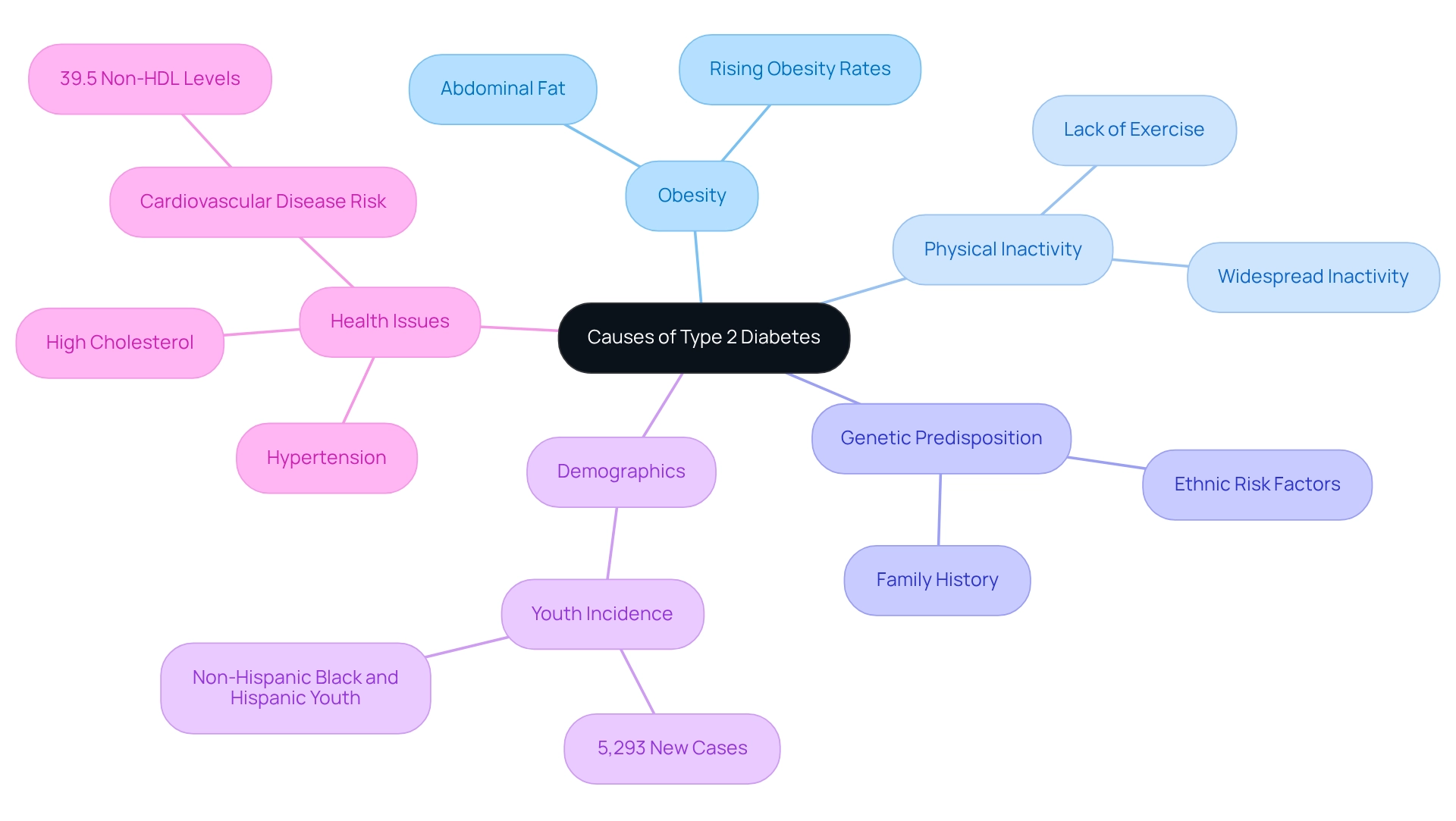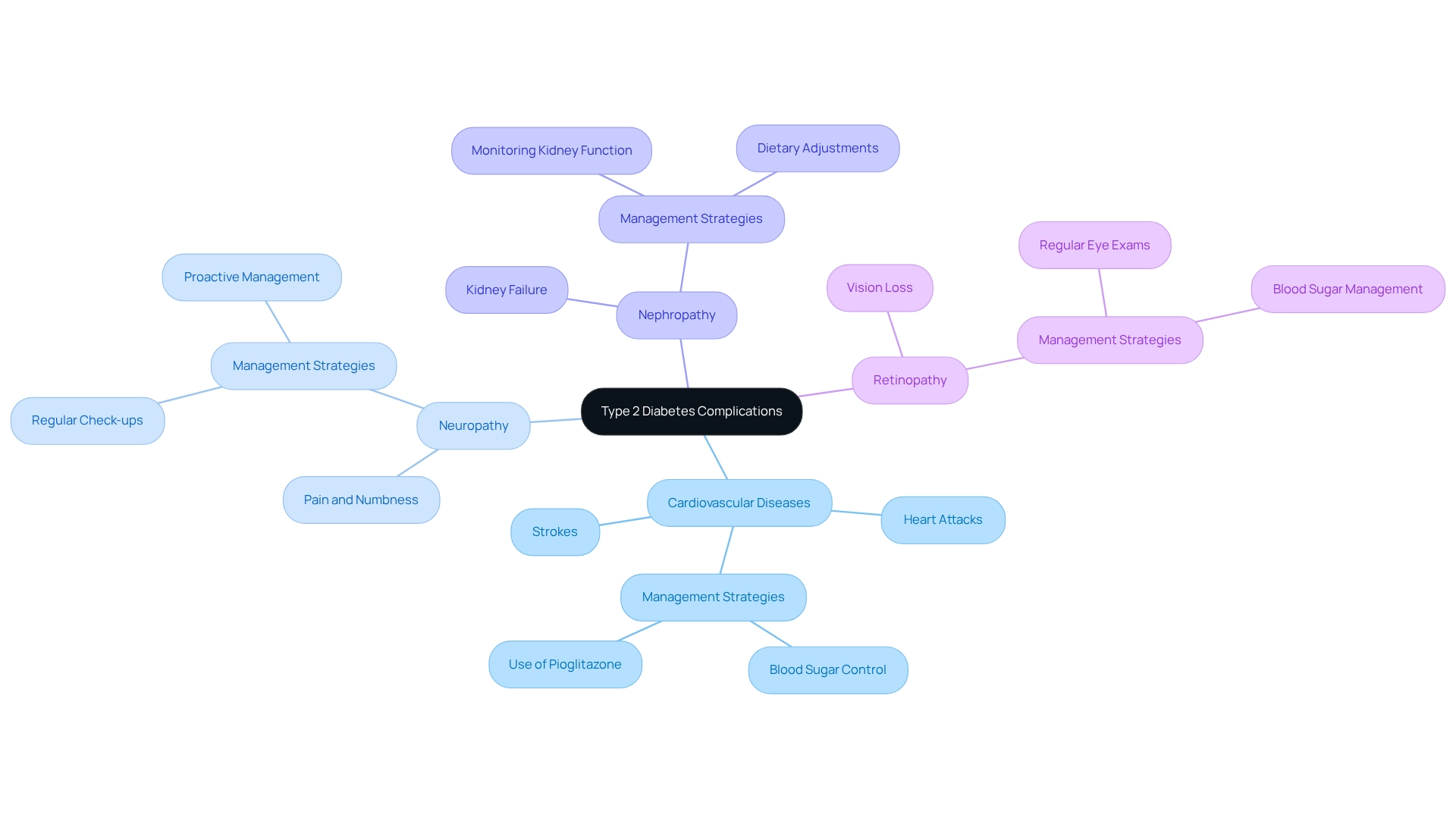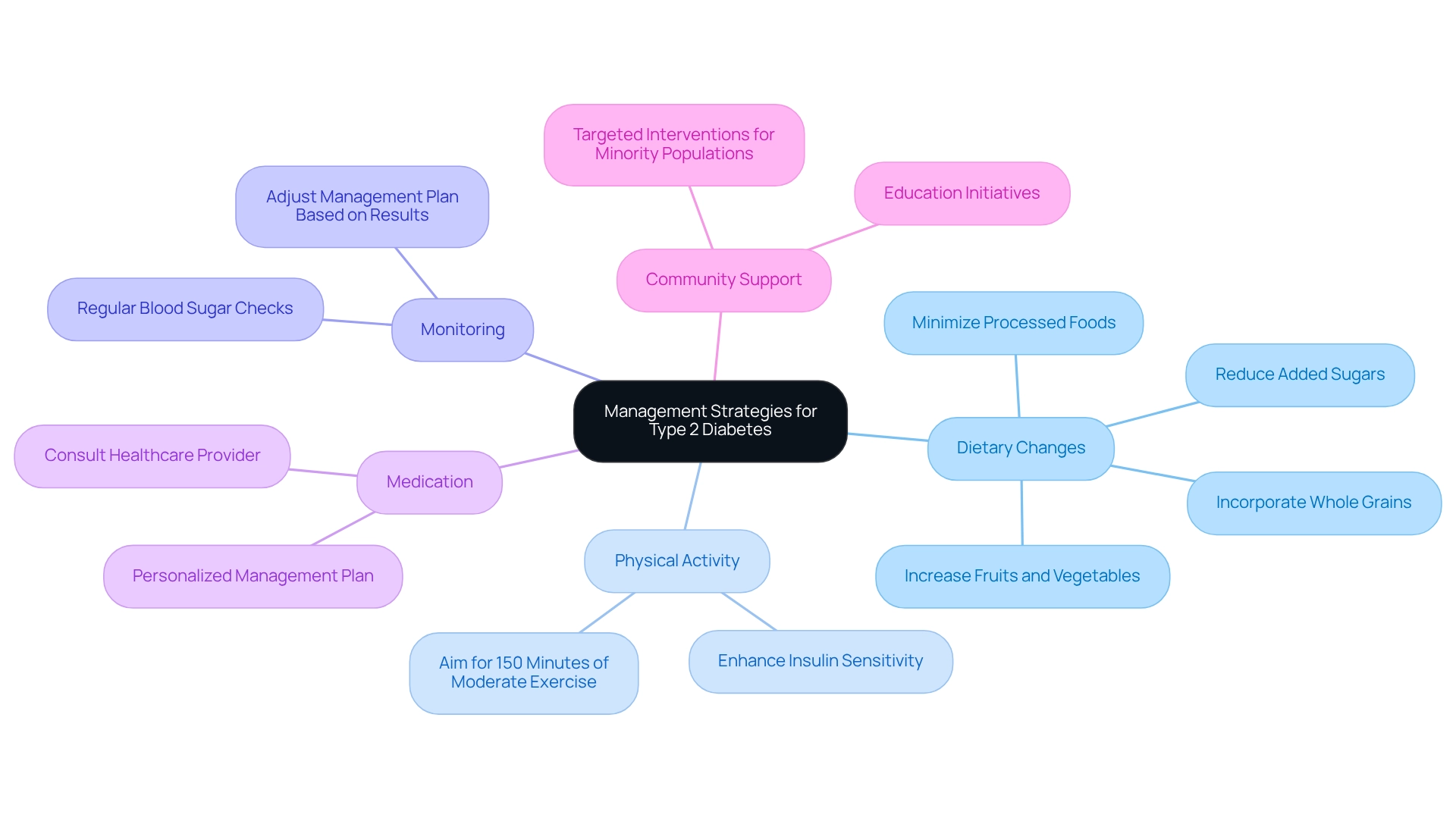Overview
Type 2 diabetes is a chronic metabolic condition that many people face, characterized by insulin resistance and elevated blood glucose levels. It is often linked to factors such as obesity, sedentary lifestyles, and genetics. If you or someone you know is navigating this diagnosis, it’s important to understand that you are not alone in this journey.
The rising prevalence of Type 2 diabetes brings with it serious health complications, including cardiovascular diseases and neuropathy. This situation highlights an urgent need for effective management strategies and community support. By making lifestyle changes and prioritizing education, we can work together to improve patient outcomes.
It’s understandable to feel overwhelmed, but there are resources available to help you. We encourage you to seek support from healthcare professionals and connect with others facing similar challenges. Remember, we are here to support you every step of the way.
Introduction
In a world where Type 2 Diabetes is becoming increasingly prevalent, understanding this chronic condition is more crucial than ever. With over 500 million adults affected globally, it’s understandable to feel overwhelmed by the implications of unmanaged diabetes, which extend far beyond elevated blood sugar levels. This condition can lead to severe health complications like cardiovascular disease and kidney failure.
As the landscape of diabetes care evolves, resources such as T2DSolutions are emerging to empower you through education and community support. By exploring the intricate causes and significant health effects, you can take informed steps toward better health and improved quality of life.
Remember, you’re not alone in this journey; together, we can navigate the complexities of Type 2 Diabetes with confidence and resilience.
Define Type 2 Diabetes: Understanding the Condition
What is diabetes 2 type is a long-lasting metabolic condition that can feel overwhelming. What is diabetes 2 type is a condition characterized by increased blood glucose levels due to insulin resistance and a relative lack of insulin production. Unlike Type 1 diabetes, where the pancreas fails to generate insulin, individuals with Type 2 can still produce insulin, but their bodies do not utilize it effectively. What is diabetes 2 type is a condition that typically develops gradually and is closely linked to factors such as obesity, a sedentary lifestyle, and genetic predisposition.
It’s concerning to note that globally, the prevalence of what is diabetes 2 type has reached alarming levels, with estimates indicating that over 500 million adults are living with the condition as of 2025. This surge is particularly troubling, as it is associated with severe long-term complications, including cardiovascular disease and kidney failure. These complications significantly increase mortality risk among affected individuals, highlighting the urgent need for effective management strategies.
As T2DSolutions launches as a new resource hub for diabetes education and community support, it aims to provide valuable information and resources for newly diagnosed patients. Recent research emphasizes the importance of early intervention and education in managing what is diabetes 2 type. Community-based education programs have shown promise in improving patient outcomes by promoting lifestyle changes and enhancing self-management skills.
T2DSolutions will provide access to programs that assist patients in managing their condition more efficiently, while also educating them on what is diabetes 2 type, including key characteristics such as increased thirst, frequent urination, fatigue, and blurred vision. Understanding what is diabetes 2 type and its characteristics is essential for timely diagnosis and effective management.
Moreover, the worldwide statistics on insulin resistance among individuals with Type 2 diabetes highlight the necessity for focused interventions, especially in high-risk groups. Experts, including Md. Rabiul Islam, advocate for enhanced healthcare initiatives, including regular screenings for individuals aged 45 and older, to facilitate early detection and management of this pervasive condition.
T2DSolutions will support these initiatives by providing educational resources and community support to empower you in your diabetes management journey. Remember, you're not alone in this journey; we are here to support you every step of the way.

Explore Causes of Type 2 Diabetes: Risk Factors and Triggers
The origins of what is diabetes 2 type are complex and varied, involving several essential contributors that play a crucial role. To grasp what is diabetes 2 type, it's important to understand that obesity, particularly the accumulation of abdominal fat, is a primary contributor to insulin resistance, a hallmark of this condition. Recent statistics reveal that obesity rates continue to climb, significantly linked to the growing occurrence of sugar intolerance. In fact, among youth aged 10 to 19, 5,293 new instances of what is diabetes 2 type were identified. This highlights the urgent need to tackle obesity as a significant contributing factor.
Looking ahead, projections for 2025 indicate that obesity rates will remain a serious issue, further worsening the epidemic of high blood sugar. Physical inactivity is another key element affecting what is diabetes 2 type. It's crucial to engage in consistent physical activity to preserve insulin sensitivity; an inactive lifestyle can heighten the likelihood of developing this condition. Recent information shows that a deficiency in physical exercise is widespread across different demographics, further increasing the risk of health issues. Understanding the link between inactivity and what is diabetes 2 type is essential for comprehending how lifestyle choices influence health outcomes. Additionally, genetic predisposition plays an important role; individuals with a family history of diabetes face a considerably elevated risk. This genetic component, combined with environmental factors such as diet and lifestyle, creates a complex interplay that can lead to the onset of the disease. Additionally, age, ethnicity, and existing health issues like hypertension and high cholesterol contribute to the overall danger profile. Recent research, including findings from the SEARCH for Diabetes in Youth study, raises concerns about what is diabetes 2 type, as there is a concerning rise in its occurrence among young individuals, particularly within non-Hispanic Black and Hispanic communities. This trend underscores the necessity for focused preventive actions and education directed at younger individuals.
Comprehending these risk factors is essential for effective prevention and early intervention strategies. By addressing obesity, promoting physical activity, and recognizing genetic risks, individuals can take proactive steps toward understanding what is diabetes 2 type and consequently reducing their likelihood of developing it. Moreover, as emphasized by recent research, including results from NEJM, metabolic surgery has demonstrated encouraging outcomes in addressing obesity, with the condition remaining in remission for up to two years in a notable percentage of patients with a high BMI. This reinforces the importance of obesity management in diabetes prevention and care. You're not alone in this journey, and there are resources available to support you every step of the way.

Examine Effects of Type 2 Diabetes: Health Implications and Complications
Condition 2 of sugar imbalance can lead to serious health issues if not managed properly. One of the most significant risks is the development of cardiovascular diseases, such as heart attacks and strokes, which result from damage to blood vessels. It's important to note that individuals with what is diabetes 2 type face a notably higher risk for these conditions. Recent studies have highlighted the challenges in predicting cardiovascular disease (CVD) within this group. While current methods like blood tests are used, they often miss at-risk individuals, underscoring the need for better predictive models. A recent systematic review and meta-analysis published on January 22, 2024, emphasizes the importance of precise prognostics in assessing cardiovascular risks for individuals with diabetes mellitus.
In addition to cardiovascular issues, uncontrolled blood sugar can lead to neuropathy, characterized by pain and numbness in the extremities, and nephropathy, which can progress to kidney failure. Retinopathy is another serious complication that may result in vision loss, while foot problems can escalate to the point of requiring amputations. Current data reveals that around 50% of individuals with what is diabetes 2 type experience some form of neuropathy. This statistic highlights the critical importance of proactive management and regular medical check-ups.
Recent research has shed light on the connection between high blood sugar levels and cardiovascular health. Studies suggest that effectively managing this condition can significantly reduce the chances of CVD. For example, Pioglitazone has been linked to a lower risk of metabolic disorders, ischemic stroke, and myocardial infarction in individuals without the condition, demonstrating how management can positively influence health outcomes.
Real-world examples illustrate the impact of these complications. Case studies show that individuals who neglect their blood sugar management often face severe health consequences. One study titled 'Challenges in Predicting CVD in Type 2 Diabetes Patients' identified potential indicators that could help determine what is diabetes 2 type and which patients are most likely to develop CVD. This insight suggests that clinicians could provide targeted advice and treatment. Expert opinions from cardiologists, including insights from R.J.dS., reinforce the idea that the risks associated with this condition extend beyond blood sugar levels. This highlights the importance of comprehensive care that addresses all potential health complications.
As T2DSolutions launches as a new resource hub for diabetes-related education and community support, it aims to provide essential resources for newly diagnosed patients. By offering educational materials and community connections, T2DSolutions will help individuals manage their diabetes effectively, bridging the gaps in knowledge and support that can lead to serious health complications. This comprehensive approach is crucial for improving outcomes and enhancing the quality of life for individuals living with 2 mellitus.

Implement Management Strategies: Effective Approaches to Control Type 2 Diabetes
Managing what is diabetes 2 type is a journey that requires a comprehensive approach, blending lifestyle changes, medication, and consistent monitoring. A balanced diet is at the heart of this journey. Focus on incorporating whole grains, fruits, and vegetables into your meals, while minimizing processed foods and added sugars. Research shows that making these dietary changes can significantly impact blood sugar regulation, underscoring the vital role nutrition plays in managing your health.
In Saudi Arabia, the global burden of what is diabetes 2 type is evident, as seen in the DALY count of 391 thousand, which highlights the urgent need for effective management strategies. Regular physical activity is just as essential. Aim for at least 150 minutes of moderate exercise each week. This can help enhance your insulin sensitivity and overall well-being.
Monitoring your blood sugar levels is crucial to understand what is diabetes 2 type, as it allows you to see how your daily choices affect your condition, enabling timely adjustments to your management plan. Sometimes, medication may be necessary to keep your blood sugar levels within a healthy range. Collaborating with your healthcare provider to create a personalized management plan is key to achieving the best health outcomes.
Case studies have shown that targeted interventions, particularly in minority populations, can lead to significant improvements in managing blood sugar levels. This emphasizes the need for urgent public health initiatives focused on education and community support. Notably, non-Hispanic Black children and adolescents face the highest incidence of Type 2 Diabetes, which highlights the demographic challenges that require focused efforts.
By embracing these strategies and recognizing the importance of community support and education, you can take proactive steps toward controlling your diabetes and improving your quality of life. Remember, you are not alone in this journey; we are here to support you every step of the way.

Conclusion
Type 2 Diabetes presents significant challenges, impacting millions around the world and leading to serious health complications if not managed properly. It's understandable to feel overwhelmed by this chronic illness, but understanding the condition, its risk factors, and the implications of poor management is crucial. The intricate relationship between obesity and insulin resistance, along with the alarming rise in diabetes cases among youth, highlights the urgent need for targeted preventive measures and education.
Effective management strategies are essential in controlling Type 2 Diabetes. Emphasizing a balanced diet, regular physical activity, and personalized medication plans can empower you to take charge of your health. Resources like T2DSolutions offer invaluable support, providing education and community connections to help you manage your diabetes effectively. This holistic approach not only addresses immediate health concerns but also fosters long-term well-being.
Ultimately, navigating through Type 2 Diabetes is a journey best not faced alone. By leveraging available resources and embracing proactive lifestyle changes, you can significantly improve your health outcomes and quality of life. Remember, you're not alone in this journey. Together, through education and community support, it is possible to navigate the complexities of this condition with confidence and resilience.
Frequently Asked Questions
What is Type 2 diabetes?
Type 2 diabetes is a long-lasting metabolic condition characterized by increased blood glucose levels due to insulin resistance and a relative lack of insulin production. Unlike Type 1 diabetes, individuals with Type 2 can still produce insulin, but their bodies do not utilize it effectively.
How does Type 2 diabetes develop?
Type 2 diabetes typically develops gradually and is closely linked to factors such as obesity, a sedentary lifestyle, and genetic predisposition.
What is the prevalence of Type 2 diabetes globally?
As of 2025, over 500 million adults are estimated to be living with Type 2 diabetes, indicating a concerning surge in the condition.
What are the long-term complications associated with Type 2 diabetes?
Long-term complications of Type 2 diabetes include cardiovascular disease and kidney failure, which significantly increase mortality risk among affected individuals.
What is T2DSolutions?
T2DSolutions is a new resource hub for diabetes education and community support aimed at providing valuable information and resources for newly diagnosed patients.
Why is early intervention and education important in managing Type 2 diabetes?
Recent research emphasizes that early intervention and education are crucial for managing Type 2 diabetes, as community-based education programs can improve patient outcomes by promoting lifestyle changes and enhancing self-management skills.
What symptoms are associated with Type 2 diabetes?
Key characteristics of Type 2 diabetes include increased thirst, frequent urination, fatigue, and blurred vision.
What recommendations do experts make for early detection of Type 2 diabetes?
Experts advocate for enhanced healthcare initiatives, including regular screenings for individuals aged 45 and older, to facilitate early detection and management of Type 2 diabetes.
How does T2DSolutions support individuals with Type 2 diabetes?
T2DSolutions provides educational resources and community support to empower individuals in their diabetes management journey, emphasizing that they are not alone in this process.



